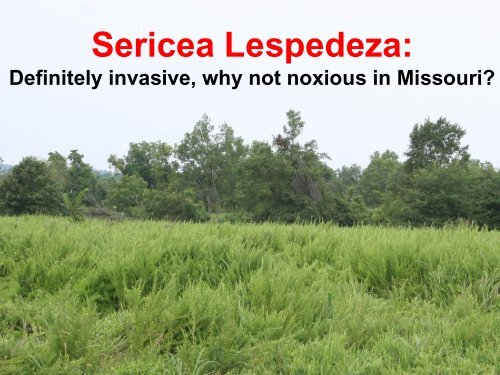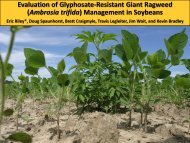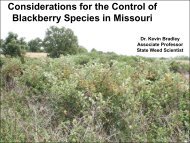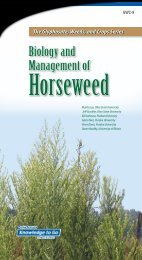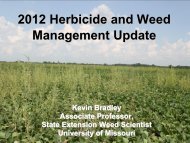Sericea Lespedeza: - Weed Science
Sericea Lespedeza: - Weed Science
Sericea Lespedeza: - Weed Science
You also want an ePaper? Increase the reach of your titles
YUMPU automatically turns print PDFs into web optimized ePapers that Google loves.
<strong>Sericea</strong> <strong>Lespedeza</strong>:<br />
Definitely invasive, why not noxious in Missouri?
<strong>Sericea</strong> <strong>Lespedeza</strong><br />
(<strong>Lespedeza</strong> cuneata L.)<br />
• Perennial legume native<br />
to eastern Asia<br />
• Introduced into the U. S.<br />
in the late 1890’s as a<br />
potential forage species<br />
and also planted for<br />
erosion control<br />
• Declared a noxious weed<br />
in Kansas and Colorado,<br />
spreading and becoming<br />
more problematic in<br />
many other states
<strong>Sericea</strong> <strong>Lespedeza</strong><br />
Prolific Seed Producer: at least<br />
1,000 seed per stem; ~600 lbs<br />
seed/A (Guernsey 1970;<br />
Ohlenbusch et al. 2001)<br />
Allelopathic: <strong>Sericea</strong> lespedeza<br />
residues reduced the germination,<br />
emergence, and biomass of rye and tall<br />
fescue (Kalburtji and Mosjidis 1993)
Official Noxious <strong>Weed</strong>s of Missouri<br />
1. Canada Thistle, Cirsium arvense<br />
2. Common Teasel, Dipsacus fullonum<br />
3. Cutleaf Teasel, Dipsacus laciniatus<br />
4. Field Bindweed, Convolvulus arvensis<br />
5. Johnsongrass, Sorghum halepense<br />
6. Kudzu, Pueraria montana var. lobata<br />
7. Marijuana, Cannabis sativa<br />
8. Multiflora Rose, Rosa multiflora<br />
9. Musk Thistle, Carduus nutans<br />
10. Purple Loosestrife, Lythrum salicaria<br />
11. Scotch Thistle, Onopordum acanthium<br />
12. Spotted Knapweed, Centaurea stoebe
<strong>Sericea</strong> <strong>Lespedeza</strong> Distribution<br />
Source: USDA, NRCS Plants Profile Database<br />
<strong>Sericea</strong> <strong>Lespedeza</strong> Present<br />
<strong>Sericea</strong> <strong>Lespedeza</strong> Not Present<br />
Infested about 8.3 million acres in U.S. in 2003<br />
(Duncan and Clark 2005)
Grazing ?<br />
• Tannin content increases dramatically<br />
with maturity; 6% in 4 inch plants,<br />
21% in 36 inch plants (Stitt 1943).<br />
• Cattle may graze it when young, but<br />
almost never when plants are > 4-6<br />
inches tall.<br />
• Dead stems from previous year persist<br />
into the summer, making it difficult for<br />
cattle to graze new growth (Koger et<br />
al. 2002).
Economic Impact ?<br />
• Average annual forage loss of $29<br />
million in Flint Hills region of Kansas<br />
(Scott 1995)<br />
• Long-term economic impact studies<br />
have shown a reduction in the 30-yr net<br />
present value of grazing land in Kansas<br />
from $294/acre for non-infested land to<br />
$74/acre for infested land
Previous Management Recommendations<br />
Triclopyr or triclopyr-containing herbicides<br />
applied in the vegetative stage, earlier in<br />
the growing season (June-July)<br />
Metsulfuron or metsulfuron-containing<br />
herbicides applied in the early bloom<br />
stage, late in the summer/early fall (August-<br />
September)<br />
Altom et al. 1992; Koger et al. 2002; Ohlenbusch et al. 2001
Influence of Selected Herbicides on <strong>Sericea</strong><br />
<strong>Lespedeza</strong> Density 1 Year After Treatment (YAT)<br />
Treatments a<br />
Trial Year<br />
Rate 2004 2005<br />
product / Acre ----Density 1 YAT (# plants/m 2 )----<br />
PastureGard 1.5 pts 10 bc 35 bc<br />
PastureGard 2 pts 6 c 25 c<br />
Surmount 2 pts 14 b 44 b<br />
Cimarron 0.4 oz 11 bc 27 c<br />
Remedy 1.5 pts ----- 27 c<br />
Untreated -------------- 42 a 93 a<br />
b a<br />
All treatments applied with a non-ionic surfactant at 0.25% v/v.<br />
Means within a column followed by the same letter are not significantly<br />
different, LSD = 0.05.
Influence of Selected Herbicides and Application Timings on<br />
<strong>Sericea</strong> <strong>Lespedeza</strong> Control (Green Conservation Area, 2008-2009)<br />
Treatments Rate<br />
<strong>Sericea</strong> <strong>Lespedeza</strong> Control<br />
Spring Herbicide<br />
Application Timing<br />
Fall Herbicide<br />
Application Timing<br />
Product/A --------- % Control 1 Year After Trtmt -------<br />
Chaparral 2.5 ozs 45 66<br />
Chaparral 3 ozs 65 84<br />
Cimarron 0.4 oz 49 57<br />
Remedy Ultra 1 pt 94 70<br />
PastureGard 2 pts 97 91<br />
LSD (0.05): 16
Influence of Selected Herbicides and Application Timings on<br />
<strong>Sericea</strong> <strong>Lespedeza</strong> Control (Green Conservation Area, 2008-2009)<br />
----------------------------------------- 1 Year After Treatment ------------------------------------------<br />
Untreated 2 pts Pasturegard 2 pts Pasturegard<br />
Spring Application Late Summer Application
Influence of Selected Herbicides and Application Timings on<br />
<strong>Sericea</strong> <strong>Lespedeza</strong> Control (Green Conservation Area, 2008-2009)<br />
----------------------------------------- 1 Year After Treatment ------------------------------------------<br />
Untreated 0.4 oz Cimarron 0.4 oz Cimarron<br />
Spring Application Late Summer Application
Latest Research / What not to Spray<br />
Untreated 6 fl ozs Milestone
Conclusions<br />
<strong>Sericea</strong> <strong>Lespedeza</strong> Control<br />
• In our research, application timing<br />
does not usually influence <strong>Sericea</strong><br />
lespedeza control 1 yr after treatment.<br />
When it does, it is typically with<br />
metsulfuron-containing products.<br />
• 1.5 pts PastureGard (62-76%), 2 pts<br />
PastureGard (73-86%), 0.4 oz<br />
Cimarron (71-74%), and 1.5 pts<br />
Remedy (71%) provided similar levels<br />
of <strong>Sericea</strong> lespedeza stem reduction 1<br />
yr after trtmt across 3 yr of research<br />
• 2 pts PastureGard has been the most<br />
consistent treatment across all years<br />
of our research, regardless of<br />
application timing.


